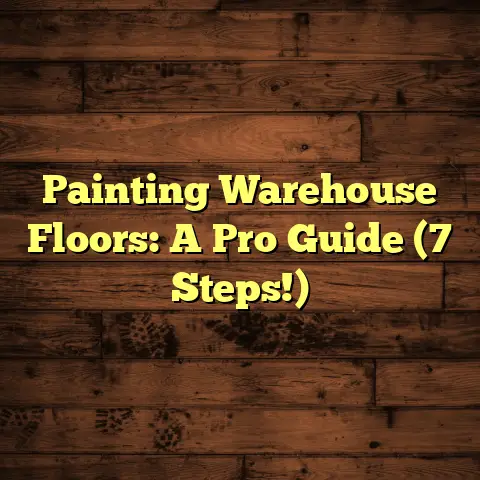Space Functionality: Flooring Is Key! (3 Tips)
Ever feel like you’re playing Tetris with your furniture, trying to squeeze everything into a space that feels way too small?
I get it.
As a flooring contractor, I’ve seen countless families struggle with this.
Maybe you’ve just moved into a cozy apartment, or your family’s outgrown your current living area.
Toys are everywhere, furniture’s crammed in, and that relaxing vibe you were going for?
Gone.
Often, the answer to creating a functional and stylish space lies right beneath our feet: the flooring.
In this article, I’ll share three essential tips to help you transform any cramped environment into a functional haven.
Let’s dive in!
Tip 1: Choose the Right Material for Your Space
Okay, let’s talk materials.
It’s not just about picking something that looks good.
It’s about finding something that works with your lifestyle.
Think about how you actually use the space.
Do you have kids and pets running wild?
Is it a high-traffic area?
Or is it a quiet space where you unwind?
Hardwood:
Classic, beautiful, and adds value to your home.
But, it can be pricey and needs some love to keep it looking its best.
I’ve seen hardwood floors look amazing in living rooms and bedrooms.
But, they can get scratched up pretty easily in high-traffic areas.
Laminate:
This is a budget-friendly option that mimics the look of hardwood or tile.
It’s super durable and easy to clean, making it a great choice for busy families.
I often recommend laminate for kitchens, hallways, and playrooms.
Tile:
Tile is a champion when it comes to durability and water resistance.
It’s perfect for bathrooms, kitchens, and entryways.
Plus, there are so many styles and colors to choose from!
However, tile can be cold underfoot, so consider adding rugs for warmth.
Carpet:
Nothing beats carpet for comfort and warmth.
It’s a great choice for bedrooms and living rooms where you want that cozy feel.
But, carpet can be a magnet for stains and allergens.
So, you’ll need to vacuum regularly.
Here’s a quick rundown:
| Flooring Material | Pros | Cons | Best For |
|---|---|---|---|
| Hardwood | Beautiful, adds value, classic look | Expensive, requires maintenance, susceptible to scratches | Living rooms, bedrooms, formal dining rooms |
| Laminate | Affordable, durable, easy to clean, mimics other materials | Can look less authentic than hardwood, not water-resistant | Kitchens, hallways, playrooms, high-traffic areas |
| Tile | Durable, water-resistant, lots of styles and colors | Can be cold, hard underfoot, can be slippery when wet | Bathrooms, kitchens, entryways |
| Carpet | Comfortable, warm, absorbs sound | Stains easily, requires regular cleaning, can trap allergens | Bedrooms, living rooms, spaces needing warmth & sound dampening |
Real-Life Scenario:
I worked with a family recently who had two dogs and three kids.
They wanted hardwood floors throughout their entire house.
I gently steered them toward a high-quality laminate that looked just like hardwood.
It was much more durable and could withstand the wear and tear of their active family.
They were thrilled with the result!
My Take:
Think about your lifestyle and how you use each space.
Don’t just go for what looks good in a magazine.
Choose a material that’s practical and will stand the test of time.
Tip 2: Consider Color and Pattern for Illusion of Space
Did you know that the color and pattern of your flooring can drastically change how big a room feels?
It’s true!
Light Colors:
Light colors reflect light, making a room feel more open and airy.
Think whites, creams, light grays, and pale blues.
These colors are great for small spaces or rooms with limited natural light.
Dark Colors:
Dark colors absorb light, which can make a room feel cozier and more intimate.
But, they can also make a space feel smaller if you’re not careful.
If you love dark colors, use them sparingly or pair them with light walls and furniture.
Patterns:
Patterns can add visual interest and depth to a room.
But, they can also be overwhelming if you choose the wrong one.
- Large Tiles: Large tiles can make a room feel more spacious. Less grout lines, means less visual clutter.
- Small Mosaic Patterns: Small mosaic patterns can add a lot of detail. But, they can also make a room feel busy and smaller.
- Stripes: Stripes can create the illusion of length or width. Run them lengthwise to make a room feel longer, or widthwise to make it feel wider.
Coordinating with Walls and Furnishings:
Your flooring shouldn’t be an afterthought.
It should complement your walls and furnishings.
- Monochromatic: A monochromatic color scheme (using different shades of the same color) can create a sense of harmony and make a space feel larger.
- Contrast: Contrasting colors can add drama and interest. But, be careful not to create too much contrast, as it can make a space feel disjointed.
Example:
I once helped a client who had a tiny bathroom.
It felt cramped and claustrophobic.
We installed large, light-colored tiles and painted the walls a soft blue.
The result was amazing!
The bathroom felt much bigger and brighter.
Data:
According to a study by the American Society of Interior Designers, light-colored flooring can increase the perceived size of a room by up to 15%.
My Take:
Don’t underestimate the power of color and pattern.
Think about the overall vibe you want to create and choose your flooring accordingly.
Lighter floors will make the space look bigger and brighter.
Tip 3: Optimize Layout with Flooring Design
The way you lay your flooring can have a big impact on how a space functions and feels.
It’s not just about slapping down the planks or tiles.
It’s about creating a visual flow that enhances the room’s architecture.
Laying Patterns:
- Straight Lay: This is the most common and simplest pattern. It’s a classic look that works well in any room.
- Diagonal Lay: Laying your flooring diagonally can make a room feel larger and more interesting.
- Herringbone: This pattern adds a touch of elegance and sophistication. It’s a great choice for hallways and entryways.
- Chevron: Similar to herringbone, but the planks are cut at an angle to create a continuous zigzag pattern.
- Plank Layouts: Varying the width and length of planks can create a more natural and organic look.
Continuity:
Creating a seamless flow from one room to another can make your home feel larger and more cohesive.
Consider using the same flooring throughout multiple rooms.
This is especially effective in open-concept living spaces.
Case Study:
I worked with a homeowner who wanted to create a more open and inviting living space.
They had a small, cramped living room that felt disconnected from the dining room.
We removed the wall between the two rooms and installed the same hardwood flooring throughout.
We used a straight lay pattern in the living room and a diagonal lay pattern in the dining room to create visual interest.
The result was a seamless and spacious living area that felt much larger than before.
Anecdote:
I remember one time, a client insisted on using different flooring in every room of their house.
It ended up feeling choppy and disjointed.
The house felt smaller than it actually was.
My Take:
Think about how you want people to move through your space.
Use flooring layout to guide the eye and create a sense of flow.
Continuity is key to making a space feel larger and more cohesive.
Data:
A study by the National Association of Realtors found that homes with consistent flooring throughout sell for an average of 5% more than homes with inconsistent flooring.
Conclusion
Flooring is more than just a surface to walk on.
It’s a foundational element of your home’s design that can dramatically affect how a space functions and feels.
By choosing the right materials, colors, and layout, you can transform any cramped environment into a functional and stylish haven.
So, take your time, do your research, and don’t be afraid to experiment.
Your floors are the foundation of your home.
Make them count!





